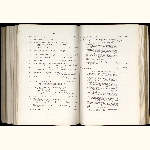Details of exhibit
- Exhibition:
- 1909 Fifty-fourth Annual Exhibition of the Royal Photographic Society of Great Britain
- Exhibit title:
- Sea Spiders
- Exhibitor:
- G. Lovegrove
- Section:
- Scientific and Technical Photography and its Application to Processes of Reproduction
- Group Title:
- PYCNOGONIDA, OR SEA SPIDER
- Exhibit No.:
- 332 333 334
- Description:
- The Pycnogonida, commonly known as "Sea Spiders." or "No Body Crabs," are a very distinct class of Marine Arthropods which have always proved a puzzle to systematic zoologists. They have at different times been classified with both the Crustacea (Crabs, &c.) and with the Arachnida (Spiders, &c.), but they are now generally regarded as an independent group, having no definite connection with either though presenting some points of resemblance to both. The most recent authority on the Pycnogonida writes: "To bring this little group into closer accord with one or other of the greater group of Arthropods is a problem seemingly simple but really full of difficulty."*
The Pycnogons are exclusively marine animals found in all seas and at all depths. At leas one small species may frequently be found in rock pools round our coast, but the group as a whole must be regarded as denizens of the deep sea, and as such they are seldom seen except by the naturalist.
The specimens photographed were taken in a trawl in the "Cold Area" of the Faroe Channel, to the N.W. of Shetland, a locality in which the group is found in great abundance. They were living on the ooze at the bottom at a depth of 775 fathoms, the temperature 3 being -1.04 C., i.e., below the freezing point of fresh water. The pressure at this depth would be more than ¾ ton to the square inch.
Without going into technical details, some of the principal features of the Pycnogonida may be summarised as follows: - They possess a "trunk," or body, which normally bears seven pairs of appendages. The first three pairs are liable to suppression, but when present the first pair carry chelae, or pincer claws; the second pair are palpiform, and are probably tactile organs; the third pair are known as the ovigerous legs, and are used by the male for carrying the eggs and, after hatching, the young brood (see photograph 32B). The remaining four pairs of appendages form the legs, and are used for walking and swimming. They are usually very long and slender, in some species reaching to a foot in length. Like many other Arthropods, the Pycnogons have the power of replacing a lost or damaged leg. The mouth organs, which are often very prominent (as in photo), are of a sucking type, but practically nothing is known as to the habits or food of these creatures. From their sluggish movements they are evidently not of predatory habits, but they have been observed to suck the juices of other animals.
Their common name of "No Body Crabs" is due to small size of the abdomen, which in all cases is atrophied almost to vanishing point. It may be seen in many of the photos as a small "peg" projecting between the hindmost pair of legs. The alimentary, nervous and circulatory system are situated in the trunk and radiate from thence into all the legs. No respiratory organs have been discovered in the group. Some forms are devoid of eyes, other have simple eyes which are placed on a king of "conning tower" raised above the trunk or body. Their colours vary is different species but are often vivid, scarlet, orange and yellow.
332 A, natural size.
(334) NYMPHON SP., DORSAL VIEW
Two of the legs on the left side carry small barnacles (pedunculata) attached. These are not parasites in the real sense of the term but merely passengers getting a free ride. The barnacle benefits only to the extent of assisted locomotion, the pycnogonid obtains no benefit but suffer no harm expect from the inconvenience of the attachment. The abdomen is visible as minute appendix.
NYMPHON SP. MALE, VENTRAL VIEW.
It is specimen the "ovigerous legs" or 3rd appendages are seen twined round a number of young individuals which remain attached to the male parent for some time after the eggs are hatched. Barnacles attached to the 2nd and 3rd legs.
334 A and B are nature size; C and D are enlargements.
(333 A.) Colossendeis proboscidea (Sabine), dorsal view. Natural size.
(333 B.) Ventral view of same specimen. The triangular opening of the proboscis is well shown, also the attachment of the "ovigerous legs."
Colour, orange scarlet.
* Professor D'Arcy W. Thompson, C.B., F.R.S., in Cambridge Natural History (1909), Vol. 4, p. 525 - Exhibit type:
- Photographic equipment and supplies
- Process:
- [Not Listed] ()
- Award:
- none

